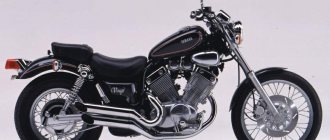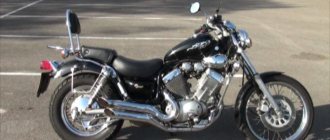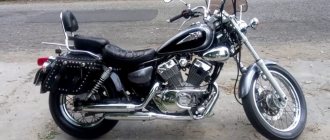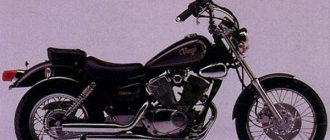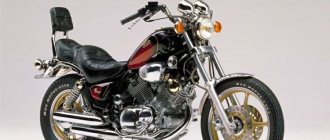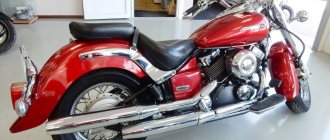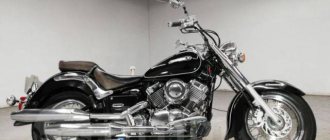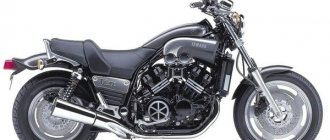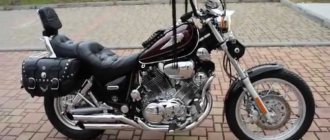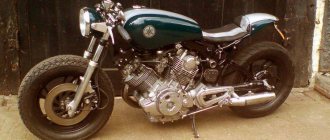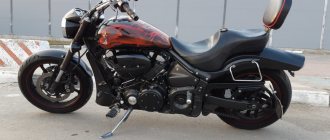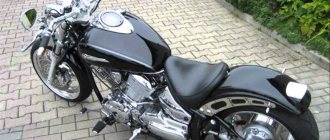Officially, the release date of the Yamaha Virago 400 is considered to be 1988. Years later, it no longer matters which of the Viraga models was born first - the 535th, an export “American”, or the training 400, intended exclusively for domestic Japanese use. The differences between these versions are only in cubic capacity. Otherwise they are almost identical. In Russia, it is the Virago 400 that is especially popular among novice bikers. Many girls give preference to the “Witch” - this is how the name of this miracle sounds in Russian. Due to what characteristics is this bike still in demand outside of Japan? This is largely due to the initial tasks facing the designers and further transformations.
Appearance
The Yamaha XV 400 Virago looks elegant. The spoked wheels are elegant. The working parts of the bike look extravagant when viewed from the front. The gas tank is small in appearance and somewhat flattened, which makes the bike even more sophisticated. Large rectangular mirrors and a distinctive chrome exhaust pipe complete the look.
The front main headlight, as well as the turn indicator lights, are made in the old style. So in terms of aesthetics, this is probably one of the best cruisers. And given current trends, it is unlikely that anything as sophisticated in this class will emerge in the future. Unless the trend becomes a return not only to retro classics, as now, but to retro cruisers.
Photo gallery
Virago 400 has its own, unique style. Although, there is an opinion that Japanese designers set themselves the task of designing a similarity to the Harley-Davidson Sportster, but the result even exceeded expectations. We bring to your attention a small photo selection of this motorcycle model.
Comfort
The motorcycle is comfortable for riding alone and for two. There is a backrest at the back, right behind the passenger seat. This kind of insurance makes the walk much safer. But this measure should not be overestimated. In any case, a cruiser is not the safest type of motorcycle for traveling together.
Handling and other driving characteristics are on par here. The car shows dynamics, despite its modest technical characteristics. Unlike large cruisers, this one is more or less comfortable in an urban environment.
At the same time, in terms of its walking properties, the model is not particularly inferior to larger ones. It's not about the engine's capabilities, but about the feeling of smoothness that occurs only when driving cruisers and similar motorcycles.
Estimated cost
The Virago 400's attitude towards motorcycles for beginners lies in its characteristics.
The small engine has acceptable power for a beginner , a low center of gravity and a small wheelbase provide excellent handling.
Production of the Virago 400 has long been discontinued, but they are available on the secondary market and are in demand among novice motorcycle owners, since in addition to good technical characteristics, these motorcycles are also relatively inexpensive .
The simplicity of the design of this bike significantly affects reliability and maintainability.
The cost varies from 90 to 160 thousand rubles.
We offer you a review of another bike for beginners - the Honda Shadov 400, because it looks solid and its technical indicators are moderate.
This article disassembles a 400 cc motorcycle from Kawasaki:
Dimensions and weight
This is an average cruiser. The car looks large, but it cannot be compared in size with the largest representatives of the class. But regarding a motocross motorcycle, a sportbike or road motorcycles, the difference is immediately visible. Just one look at the photo is enough to make sure that this is a really large car.
The dimensions of the Yamaha XV 400 Virago are as follows:
- height – 1115 mm;
- width – 725 mm;
- length – 2225 mm;
- wheelbase – 1520 mm;
- saddle height – 720 mm;
- ground clearance – 160 mm;
- curb weight – 199 kg;
- Tank capacity – 13.5 l.
The ground clearance is quite high for a cruiser. So on not too bad roads the bike will not suffer and will pass this test with honor. However, the model is not suitable for off-road use, like any other cruiser. This is natural for the class, and there is nothing to complain about.
So you should use this and any other cruiser with caution, remembering that this is not a touring enduro.
"Witch"
Most fans of the model are sure that the word “Virago” translates as “Witch”. The image of a free, brave and beautiful sorceress flying in the night seems simply magical. And it fully matches the appearance and performance characteristics of the Yamaha Virago motorcycle. However, the original meaning of this word is somewhat different. It is translated as “masculine woman,” as evidenced by any dictionary. The creators put into the motorcycle the image of a stern warrior rather than a pretty witch.
And the name turned out to be suitable. “Virago” is endowed with a masculine character, excellent endurance and unprecedented strength.
Specifications
In terms of filling, the Yamaha XV 400 Virago looks modest. This is not surprising, given the year in which production of the model began. The bike looks interesting in dynamics, which can be seen in the video. However, the merit of this does not lie in the engine, but in the balanced chassis and transmission.
| Motor type | V-shaped, 2 cylinders, 4 strokes |
| Power | 40 hp |
| Torque | 34.3 Nm |
| Maximum speed | 135 km/h |
| Acceleration to 100 | 7.5 s |
| Fuel consumption per hundred | 5.5 l |
| Drive unit | gimbal |
| Transmission | five-speed |
| Frame | steel duplex |
| Rear suspension | telescopic fork, travel 140 mm |
| Front suspension | pendulum, two shock absorbers, stroke 100 mm |
| Rear brakes | drum, 130 mm |
| Front brakes | single disc, 298 mm, 2-piston caliper |
Of course, on such a relatively powerful bike it’s definitely time to install a disc brake. And the fact that they didn’t do this is apparently due to the fact that in those days the drum version was considered normal. Perhaps this will appeal to connoisseurs of older representatives of this class, but those who prioritize safety are unlikely to be satisfied.
Tuning
As they say, there is no limit to perfection. So the owners of the Yamaha chopper are trying to improve the motorcycle in every possible way. An additional incentive is provided by the wide range of additional accessories that the manufacturer offers. Most often, changes concern the appearance of the “iron horse.” Users equip it with a body kit, updated mirrors, sensors and seats.
One of the most optimal tuning options is to replace the steering wheel, overcook the exhaust system, and install new brakes and wheels. Those owners who are tired of the standard color of the car repaint it in specialized workshops according to their taste and preferences. Some craftsmen manage to weld strollers, mount panniers, or make a more powerful variation out of an existing model by afterburning or replacing the engine.
History of changes
Changes took place only in 1989. The rest of the time, nothing really changed, because there was no reason for it.
Here's what was changed:
- The total volume of the fuel tank increases.
- The seat is divided into two parts.
- Now you can remove the passenger part of the seat, where the glove compartment will be.
Yes, the glove compartment is small, but it’s better than nothing. If the bike continued to be produced, it would be logical to expect a replacement of the drum brake with a disc brake.
V-shaped heart
The main characteristic of the Yamaha Virago is its very reliable and durable engine. The owners describe many of its advantages, while highlighting only one drawback. According to reviews, the Japanese “Witch” does not have the most successful oil pan. The crankcase itself is located low, as a result of which it is easy to damage on uneven roads. With a relatively strong impact, it may crack.
The entire Virago series has one more drawback - a problem with the starter bendix.
What do the owners say?
Many people are interested in the driving performance of this model. One review colorfully describes how a man tried to ride this bike in the outback, including on rural roads. The result is not the most rosy - I had to look for spare parts. So it's clear that, like most in this class, this bike is designed for the trail and nothing else.
Owners of this and other old bikes are advised to calculate before purchasing how much servicing of such equipment will ultimately cost. A new XV 400 Virago is no longer available, and used ones are usually in questionable condition. First of all, it is important to pay attention to the rear brake, because it is with it that problems most often arise after a serious mileage.
Judging by the reviews, the car is well suited for traveling from one city to another. Stability on the highway is noted. They say that traveling short distances within civilization on this motorcycle is a pleasure.
According to those who have ridden in different weather conditions, the bike performs best in dry weather. They also note that the car is stable in strong winds. This is important when traveling on a highway somewhere in the steppe. Pay special attention to storage conditions. The car will already be worn out to some extent, and it is important to treat it with special care.
In conclusion, it is worth noting that the Yamaha XV 400 Virago is a very beautiful bike, but it is far from the most practical and safe. However, if beauty in technology and its age are paramount, then connoisseurs will certainly be pleased with such an acquisition.
Known weaknesses and breakdowns of the Yamaha Virago 400 (XV400)
Looking ahead, it should be noted that the motorcycle is indeed very reliable, but due to the fact that even the youngest model is far from young, it also has characteristic problems. First of all, you need to pay attention to the integrity of the motorcycle frame under the driver’s seat. Due to age and use on not the best roads by not the best drivers, you can find cracks in the pipes. There is only one way out - to cook.
In addition, the inherent failures of the Yamaha Virago 400 include wear of the overrunning clutch rollers. It is not entirely clear why this is classified as a breakdown when it is essentially a maintenance procedure. With this logic, brake pad wear can also be attributed to motorcycle breakdowns.
Next on the list is electrics, honestly a generator and a relay-voltage regulator. In most cases, breakdowns occur again due to age and, for many, it will be a discovery, the age of the contact groups, which oxidize and lead to such sad consequences as a burnt-out generator winding or a failed relay-regulator. The wiring of a particularly old motorcycle needs to be monitored, or it is better to replace it and not expect surprises at the most inopportune moment.
You can also come across complaints about engine overheating. To be objective, only a very talented and purposeful person can overheat the engine of a Yamaha Virago 400. And we can only guess whether such unique people are still alive on earth, or whether those who saw the motorcycle in the picture and, noticing the air-cooled engine, assumed that it was overheating are writing about overheating.
Video
Yamaha Virago XV 1000
- a motorcycle produced back in the 80s. It belongs to the Virago series, and is a kind of hybrid between the 750 cc and 1100 cc versions of this motorcycle.
Due to their age, these motorcycles are now rarely seen, like even older 920 cc versions, and at the same time the XV 1000 shares common features with the 700cc, 750cc, 920cc, and 1100cc Viragami. There are actually few structural differences, but they still exist.
The main difference is that the XV 1000 had a crankshaft from the 700/750/920 cc versions, which was different from the crankshaft of the 1100 cc version. In addition, the pistons also differ - on 700-1000 cc Viragos the piston diameter is 92 millimeters, and on the Yamaha Virago 1100 - 95 millimeters. Thanks to a shorter stroke shaft with the same cylinder-piston group, the XV 1000, oddly enough, produces better performance in both maximum power and torque than the 1100cc. True, you have to pay for this with slightly less thrust in the lower rev range (again, compared to 1100cc; the XV 1000 still has this figure better than all the younger versions). Perhaps this was the reason why the XV 1000 did not last long on the assembly line.
Externally, the XV 1000 is practically no different from the 750/1100cc Virag, which themselves differ only in the piston, not counting other minor differences. One of the features of the XV 1000 is the standard Hitachi carburetors (the same ones were installed on the XV750), which are notorious for their capricious behavior and the total lack of repair kits for them. However, this can be corrected by purchasing and installing Mikuni carburetors from older versions of the XV1100.
Otherwise, these motorcycles are 99% structurally similar, and the owner of the XV 1000 will not have problems finding spare parts and consumables, despite the fact that the Virago series has been out of production for a decade and a half. There were a lot of these motorcycles produced, and they are still popular, so there is quite enough both tuning and spare parts for them. Accordingly, one hundred percent of all components and parts will fit on the XV 1000 from either its 750cc or 1100cc counterparts.
Suspension
The thin 35 mm fork stays twist quite noticeably during heavy braking and during active steering attempts. The silent blocks of the shock absorbers located at the rear quickly become unusable if you drive frequently with a passenger. In addition, the rear suspension is too soft for two-person driving.
However, motorcycle owners claim that with Yamaha’s developed dealer network and ample opportunities for tuning, the above problems can easily be eliminated. Purchasing gas-filled shock absorbers will ensure comfortable riding and eliminate the need for frequent repairs.
Peculiarities
The bike has quite a few differences:
- 2 springs on the rear shock absorber;
- rear wheel drum brake;
- large stroke of brake levers;
- I inherited from my progenitor a sore with an overrunning clutch (and you always need to keep a few in reserve in the garage);
- cooling system - even with an air filter, the bike does not overheat either when riding or when standing in traffic jams;
- the need to very accurately adjust/synchronize carburetors;
- Sometimes there are problems when starting (it doesn’t depend on the weather outside - a legacy from the XV 750), but it can be adjusted.
Of course, the key feature is called the cardan drive - change the oil and all maintenance on time.
Video
Virago XV 400
– this motorcycle is very popular among novice bikers, not least because of its affordable price.
A living device can be purchased for 100 thousand rubles, or even less if you’re lucky. Of all the 400 cc classmates, the Virago 400 is one of the most peppy bikes. Thanks to its low weight (about 150 kg) and 40 hp. it is very, very dynamic at speeds from 0 to 100 km/h. After a hundred, of course, it begins to quickly deflate, and finally refuses to accelerate when the speedometer marks 140 km/h. The heart of the XV 400 is a 2-cylinder v-shaped air-cooled engine, which is not picky about fuel quality. The author of this text, who at one time rode a Virago 1100, once personally poured 76 gasoline into the tank for lack of anything else, and nothing, the motorcycle withstood this mockery. The Virago cardan drive is reliable, as always (only the youngest Viragos - 125cc and 250cc versions - were produced with a chain drive). It is also worth mentioning that the Virago XV 400 was produced in two versions, the first of which had only one gas tank under the saddle. The Virago 400-2 has a small second gas tank instead of a false tank. This, by the way, is also true for Virago XV 535 of various years of production.
Both of the above-mentioned “witches” are built on the same base, and differ mainly only in the cylinder-piston group. If desired, the 400 cc Yamaha Virago can be converted into a 535 cc one. But the meaning of such tuning is a big question due to its tangible cost, which will never be repaid if the motorcycle is resold. Although if you manage to buy a used motor at a motor disassembly site, the final price of tuning may not be so high. In addition, if the arms grow from the right place, and their curvature does not exceed the statistical average, you can cope with replacing the motor yourself, calling your comrades for help.
The younger Yamaha Virago - 125 and 250 - are similar to each other and very different from the 400/535 and 750/1100 versions. They have their own frame and chain drive, while all other Virags have a cardan drive. Outwardly, all “Witches” are similar to each other, at least in general terms, but they all have the same style
So if you started with the youngest motorcycles in this series, and you liked them, then you should pay attention to the larger models. It's the same thing, only bigger and better
And starting to get acquainted with choppers with a Yamaha Virago 125 or 250 is a good idea if you can find them on sale. Small and light, they will be an excellent “study desk” for a beginner. Although the prices for the 400 cc version are not that much different, so perhaps it’s worth thinking about the XV 400 right away.
The older Yamaha Virago models share a different platform and, like the 400/535 versions, differ from each other mainly in the CPG.
